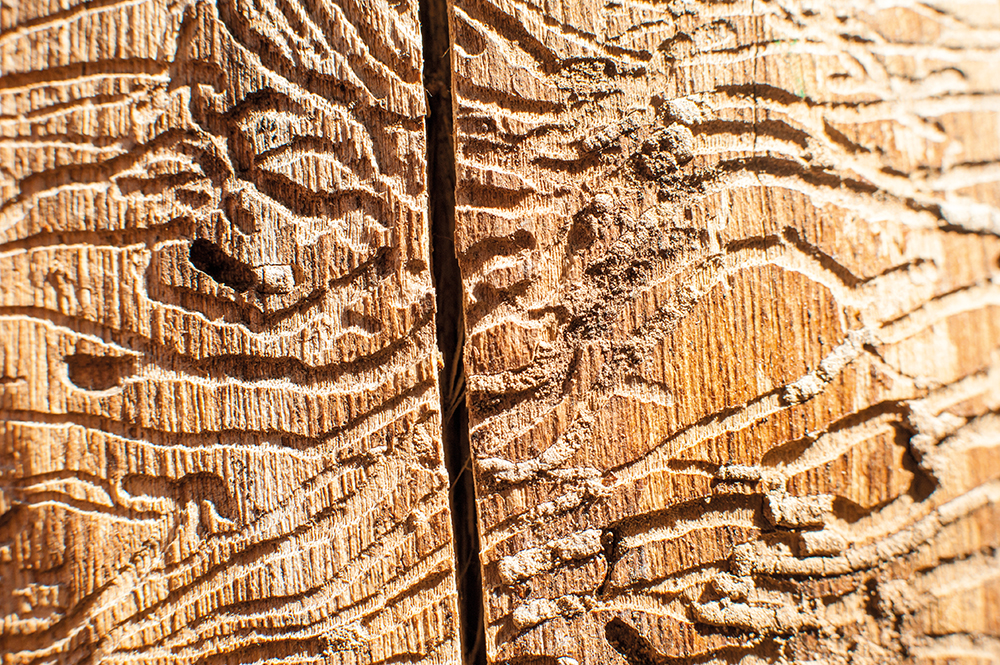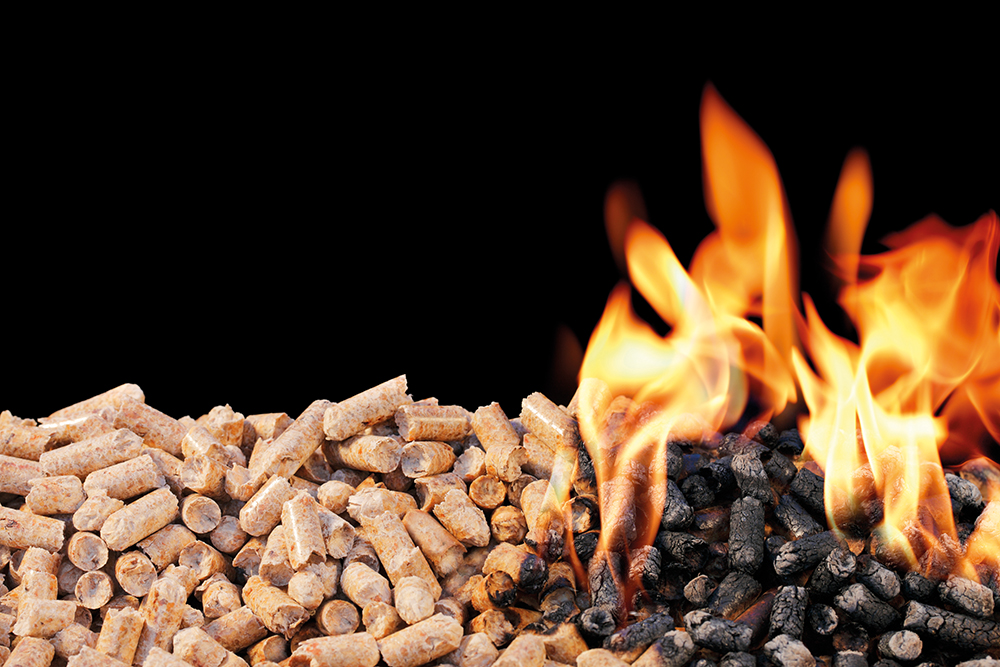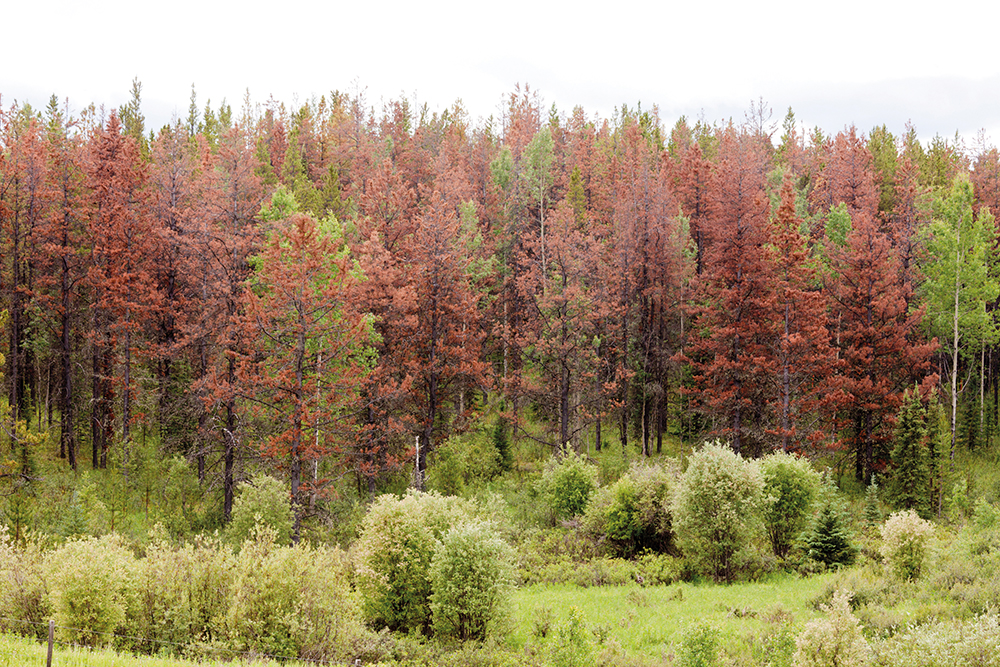Dr Cedric Ogden – Help from Above: Using Drones to Combat Pine Forest Pests
A key limitation of pest control in agriculture and forestry is the ability to detect pests and diseases early enough for effective treatment. This is exacerbated in the pine forestry industry, where plantations cover vast areas and many pests remain hidden inside the trees. Pine trees killed by beetles are often discarded, causing significant economic and environmental consequences. Dr Cedric Ogden at Fort Valley State University is developing a comprehensive loblolly pine pest-management plan, using drones to detect infestations early, and salvaging damaged timber for use as a fuel source.
Early Pest Detection
Imagine looking out across a grassy lawn. It would be fairly easy to spot any problem areas that needed your intervention. But what if you were the size of an ant? It would become an exceedingly difficult task. This is the scale of the challenge faced by foresters across the globe, with commercial forest plantations spanning across millions of acres, and some trees growing up to 50 metres tall. In the state of Georgia alone, commercial forests cover over 24 million acres of land. With the scale of the area to be covered, monitoring and maintaining the health of forest plantations has traditionally been a time-consuming and labour-intensive activity.
Forestry, by necessity, is a long-term enterprise. With many foresters planting trees that they will never themselves see harvested, catching problems early is imperative to ensuring the continued economic viability of the plantations. Some of the most devastating problems arising in pine tree plantations, such as bark beetles and other insect pests, cause entire patches of trees to die. With climate change increasing the range and abundance of some of these damaging pests, developing more robust and efficient methods of managing the health of forest plantations is vital to the forestry industry.
Unmanned aerial vehicles (UAVs), more commonly referred to as ‘drones’, offer a promising technique for managing forests and cropland. By integrating cameras, drones offer a bird’s-eye view of the land, so the health of the plants can be monitored remotely and with much greater efficiency. Specialist equipment allows the collection of important health data, which provide clues to identify what pests and diseases are present, and at what scale. Drones may also be useful in precision plant health management, by allowing smaller target areas to be treated with pesticides, herbicides and water.
Dr Cedric Ogden at Fort Valley State University, Georgia, is exploring the use of drones in forestry and agriculture with the aim of developing the technology that can be used by foresters and farmers across the globe. By incorporating his experience in engineering and agricultural management, Dr Ogden adopts an interdisciplinary approach to solve complex problems. ‘Infusing research with extension and outreach allows direct impact to the community and the people that need it most,’ he explains. ‘Understanding the issues faced allows research investigations to be more meaningful.’
His current research focusses on southern pine beetle infestations in loblolly pine plantations in Georgia. Alongside his colleagues, Dr Ogden is now developing a complete management plan for this destructive insect pest, from effective monitoring using drones, to the use of infected timber (which would otherwise be discarded) as an environmentally friendly fuel source.

Benefits and Challenges
The timber industry contributes billions of dollars to the US economy, creating hundreds of thousands of jobs. Timber uses range from housing materials and furniture to wood-based fuels and pellets. Additionally, forest plantations are environmentally beneficial. ‘Forests prevent erosion, help with filtration of water, help the soil absorb water slowly, and in turn, help prevent flooding,’ explains Dr Ogden.
A well-managed plantation is a carbon sink, capturing and storing more carbon from the atmosphere than it releases. Even plantations used predominantly to provide wood fuel for burning are at least carbon neutral, with the carbon released during burning being recaptured when new trees are planted in their place. Thus, wood fuel is a renewable and eco-friendly alternative to coal or fossil fuels. This means that well-managed forest plantations can play key roles in the fight against climate change.
However, damage caused by pests and diseases can alter the delicate balance of these forest ecosystems, by altering the water and carbon cycling within the systems, and even entirely killing off patches of trees. The decomposition from dying and dead trees prematurely releases carbon back into the atmosphere. This may shift forests from carbon sinks to carbon sources, and reduce their overall benefit in slowing climate change.
‘Infusing research with extension and outreach allows direct impact to the community and the people that need it most. Understanding the issues faced allows research investigations to be more meaningful.’

Loblolly pine is one of the most important commercial tree species in the state of Georgia, but unfortunately, it is also a favourite host of the southern pine beetle. Southern pine beetles belong to the same family as weevils, but are specially adapted to bore into the wood of trees, where they feed and reproduce inside the inner bark. They have the propensity to attack healthy trees, eventually causing the tree to die. Additional stressors, such as drought, put trees at greater risk of attack, meaning infestations may become more frequent as temperatures rise in the future. As they are hidden within the tree for much of their lifecycle, these beetles pose significant challenges for early detection.
Dr Ogden has been using drones to aid the detection of southern pine beetle outbreaks in loblolly pine forests. Recently, he successfully used drone technology to develop a crop management plan for farmers in Nigeria, using the aerial imagery to map out specific areas to target. Using drones in pine plantations not only allows dying trees to be precisely located in large areas of forest, but also allows early detection by incorporating heat-sensing technology into the surveillance.
The development of the beetle within the trees causes a rise in temperature that can be detected before external signs of damage are visible, allowing infected trees to be removed before the infestation has had chance to spread. ‘Remote sensing in aerial vehicles equipped with infrared and thermal sensors will be used to scan and identify infected areas by locking in on vegetation reduction and heat spikes caused by the disease,’ explains Dr Ogden.

Infested Wood as a Fuel Source
Once beetle-infested trees have been located and removed from the plantation, the question remains of what to do with the timber. Traditionally, the infected trees have been discarded, releasing carbon into the atmosphere as the trees decompose and causing significant economic losses.
Dr Ogden is researching the suitability of wood sourced from beetle-infested pine trees for use in combustible pellets for heating systems. As a carbon neutral energy source, these wood pellets could provide an economically and environmentally beneficial use for timber that would otherwise be unsalvageable. Dr Ogden aims to perform a comparison between the quality of wood pellets produced with infested versus non-infested wood, working closely with loblolly pine foresters from Georgia to source trees to use in the experiments.
He is interested in whether the quality of the wood pellets is similar enough to make this a viable alternative use for infested trees. To make a full assessment, Dr Ogden is analysing the chemical composition of the wood, and the density and particles within the pellets to assess their durability, and the cleanliness and efficiency of the wood pellet combustion. In comparison to other combustible fuel crops such as switchgrass, burning wood pellets created from beetle-infested pine trees may still produce less ash greenhouse gases, making it the environmentally superior choice.
To develop a full management plan – from the detection of the beetle attacks to the sale of the final product – Dr Ogden is also assessing the economic viability of processing beetle-infested loblolly pine wood into combustible pellets. This will be a key factor in encouraging foresters to take up the forest management plans he is developing.

Implications and Future Developments
Demonstrating the viability of Dr Ogden’s management plan for southern pine beetle in loblolly pine plantations will be a valuable step towards improving the economic and environmental practices in other similar pest-host forestry scenarios. Pest species of beetles, moths and aphids affect a range of tree species across the globe, with some also making trees more susceptible to secondary infection by fungal and bacterial pathogens. Through early detection with drone technology and a method of salvaging affected wood for use in a saleable product, the forestry industry could avoid significant financial losses and have a positive impact on global greenhouse gas management.
Dr Ogden’s work also extends to other agricultural systems. In particular, his drone technology could be used for identifying areas within crops affected by pests or diseases, allowing for targeted, precise treatment in those areas. This may reduce the overall use of pesticides and herbicides by mitigating the need to spray entire crop fields. He hopes to extend his drone surveillance-technology to other farming systems such as livestock production, by providing precise information about the health and quality of large areas of pasture land. ‘We want to be able to implement several things,’ concludes Dr Ogden, ‘sustainable agricultural practices, precision agricultural practices, and remote sensing.’
Reference
https://doi.org/10.33548/SCIENTIA439
Meet the researcher

Dr Cedric A. Ogden
Fort Valley State University
Fort Valley, GA
USA
Dr Cedric Ogden earned his PhD in Agricultural and Biological Engineering from Purdue University, Indiana, USA, for a project researching renewable energy sources and solid fuel handling. Currently, Dr Ogden is an Engineering Technology Assistant Professor and Cooperative Extension Specialist in Renewable Energy at Fort Valley State University. Here, he is developing drone technologies for use in agriculture and forestry monitoring, and management of pests and diseases. In addition to his research, Dr Ogden is passionate about teaching and outreach. Within his projects, he supervises and mentors several student researchers. Dr Ogden also provides external workshops, presentations and consultations on the use of natural resources as renewable energy sources, and liaises with farmers and foresters to further develop his research objectives.
CONTACT
W: https://www.caes.uga.edu/about/personnel/person.html?pk_id=19784&name=Cedric%20Ogden
FUNDING
USDA-NIFA McIntire Stennis grant

Creative Commons Licence
(CC BY 4.0)
This work is licensed under a Creative Commons Attribution 4.0 International License. 
What does this mean?
Share: You can copy and redistribute the material in any medium or format
Adapt: You can change, and build upon the material for any purpose, even commercially.
Credit: You must give appropriate credit, provide a link to the license, and indicate if changes were made.
More articles you may like
Dr Lifei Wang | Can Species Distribution Models Inform Us About Future Ecosystems?
The world is buzzing with news about how human activities and climate shifts are reshaping our ecosystems. Have you ever wondered how life will adapt to this rapidly changing world? Ecologists might be able to predict how different species will live in future using computer simulations. Dr Lifei Wang at the University of Toronto Scarborough investigates how different stimulations work under varying conditions to provide new insights into what may lie ahead.
Dr Yong Teng | Improving the Outlook for Head and Neck Cancer Patients
Dr Yong Teng at the Emory University School of Medicine is working with colleagues to overcome the high mortality of individuals diagnosed with cancers affecting the head and neck. One of his approaches is based on understanding the particular mechanisms of the ATAD3A gene, which new insights suggest are closely related to cancers affecting the head and neck.
Dr Tsun-Kong Sham – Dr Jiatang Chen – Dr Zou Finfrock – Dr Zhiqiang Wang | X-Rays Shine Light on Fuel Cell Catalysts
Understanding the electronic behaviour of fuel cell catalysts can be difficult using standard experimental techniques, although this knowledge is critical to their fine-tuning and optimisation. Dr Jiatang Chen at the University of Western Ontario works with colleagues to use the cutting-edge valence-to-core X-ray emission spectroscopy method to determine the precise electronic effects of altering the amounts of platinum and nickel in platinum-nickel catalysts used in fuel cells. Their research demonstrates the potential application of this technique to analysing battery materials, catalysts, and even cancer drug molecules.
Dr Michael Cherney – Professor Daniel Fisher | Unlocking Woolly Mammoth Mysteries: Tusks as Hormone Time Capsules
The impressive tusks found on proboscideans (the order of mammals that includes elephants, woolly mammoths, and mastodons) are like time capsules, preserving detailed records of their bearers’ lives in the form of growth layers and chemical traces. Frozen in time for thousands of years, these layers can unlock secrets about the lives of long-extinct relatives of modern elephants. Dr Michael Cherney and Professor Daniel Fisher from the University of Michigan used innovative techniques to extract and analyse steroid hormones preserved in woolly mammoth tusks. This ground-breaking work opens new avenues for exploring the biology and behaviour of extinct species.




